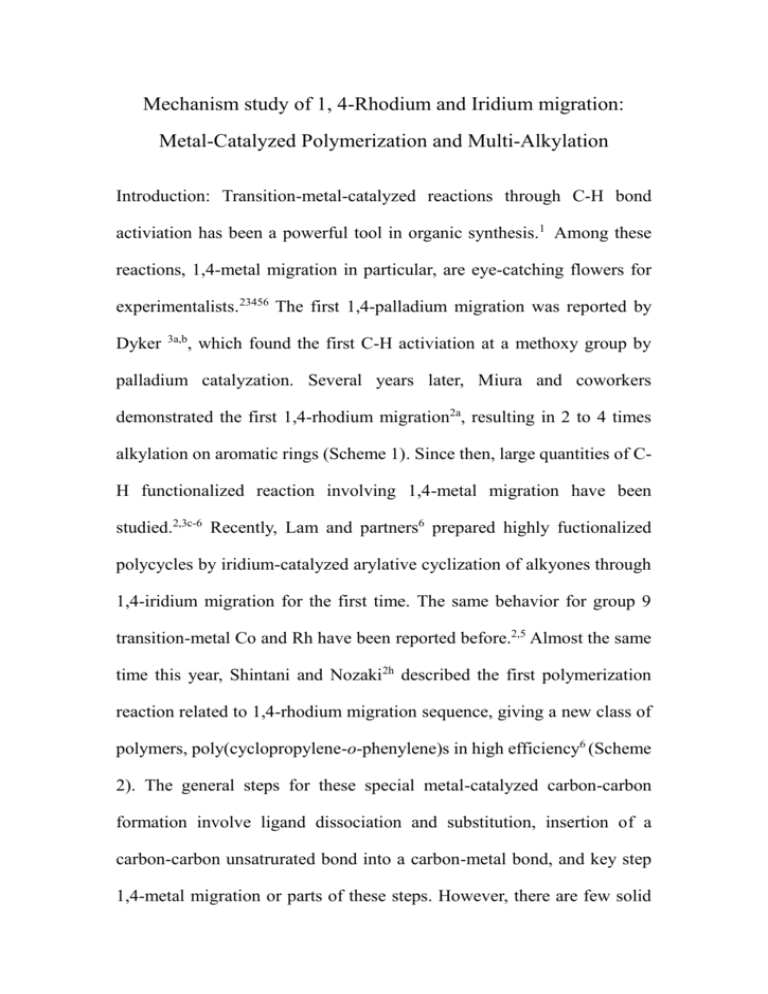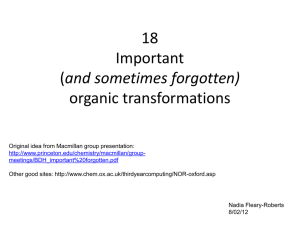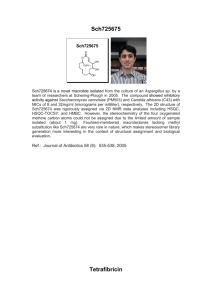2014-7.6-1,4-metal migration introduction
advertisement

Mechanism study of 1, 4-Rhodium and Iridium migration: Metal-Catalyzed Polymerization and Multi-Alkylation Introduction: Transition-metal-catalyzed reactions through C-H bond activiation has been a powerful tool in organic synthesis.1 Among these reactions, 1,4-metal migration in particular, are eye-catching flowers for experimentalists.23456 The first 1,4-palladium migration was reported by Dyker 3a,b , which found the first C-H activiation at a methoxy group by palladium catalyzation. Several years later, Miura and coworkers demonstrated the first 1,4-rhodium migration2a, resulting in 2 to 4 times alkylation on aromatic rings (Scheme 1). Since then, large quantities of CH functionalized reaction involving 1,4-metal migration have been studied.2,3c-6 Recently, Lam and partners6 prepared highly fuctionalized polycycles by iridium-catalyzed arylative cyclization of alkyones through 1,4-iridium migration for the first time. The same behavior for group 9 transition-metal Co and Rh have been reported before.2,5 Almost the same time this year, Shintani and Nozaki2h described the first polymerization reaction related to 1,4-rhodium migration sequence, giving a new class of polymers, poly(cyclopropylene-o-phenylene)s in high efficiency6 (Scheme 2). The general steps for these special metal-catalyzed carbon-carbon formation involve ligand dissociation and substitution, insertion of a carbon-carbon unsatrurated bond into a carbon-metal bond, and key step 1,4-metal migration or parts of these steps. However, there are few solid evidence and theoretical investigation for this migration. The only mechanism was proposed to undergo oxidative addition to C-H or C-X bonds, the formed trivalent intermediates for Rh-series and of tetravalent intermidiates for Pd-involved reaction, then goes reductive elimination to complete 1,4-metal migration. 6,7 Reactions contain insertion step before 1,4-metal often need a substrate like strained alkene2a,h,7a or alkyne2b,7a. For strained cyclopropenes, only a few numbers of polymerization reactions are available by controlled means.8910 Here we report detailed theoretical investigation of 1,4-rhodium migration mechanism based on 3,3diarylcylopropenes polymerization and multi-alkylation on aromatic rings. Furthermore, we studied the influence of substituents on aromatic rings and phenyl on cyclopropenes. At last, we compared the rhodium catalyzed mechanism with iridium’s. Scheme 1. Rhodium(Ⅲ )-Catalyzed Multi-alkylation on An Aromatic Ring Involving 1,4rhodium migration. Scheme 2. Rgodium( Ⅲ )-Catalyzed Polymerization of 3,3-Diphenylcyclopropene via 1,4Rhodium Migration. 1 For reviews see: (a) Metal-Catalyzed Cross-Coupling Reactions, 2nd ed. (Eds.: De Meijere, A.; Diederich, F.), Wiley-VCH, Weinheim, 2004. (b) “C-H Activation”: Topics in Current Chemistry, Vol. 292 (Eds.: Yu, J.-Q.; Shi, Z.-J.), Springer, Berlin, 2010. (c) Müler, D.; Alexakis, A.Chem.Commun.2012, 48, 12037. (d) Feng, C.-G.; Ye, M.; Xiao, K.-J.; Li, S.; Yu, J.-Q. J. Am. Chem. Soc. 2013,135, 9322-9325. (e) Mo, J.; Kang, D.; Eom, D.; Kim, S. H.; Lee, P. H. Org. Lett. 2013, 15, 26−29.(f) Li, X.; Yang, F.; Wu, Y.; Wu, Y. Org. Lett. 2014, 16, 992-995. 2 For examples of 1,4-Rhodium migration, see: (a) Oguma, K.; Miura, M.; Satoh, T.; Nomura, M.; J. Am. Chem. Soc. 2000, 122,10464. (b) Shintani, R.; Okamoto, K.; Hayashi, T. J. Am. Chem. Soc. 2005, 127, 2872. (c) Shintani, R.; Takatsu, K.; Hayashi, T. Angew. Chem. Int. Ed. 2007, 46, 3735. (d) Shintani, R.; Takatsu,K.; Katoh, T.; Nishimura, T.; Hayashi, T.; Angew. Chem. Int. Ed. 2008, 47, 1447 (e) Shigeno, M.; Yamamoto, T.; Murakami, M.; Chem. Eur. J. 2009, 15, 12929 (f) Matsuda,T.; Suda, Y.; Takahashi, A. Chem. Commun. 2012, 48, 2988 (g) Zhang, J.; Liu, F.-J.; Ugrinov, A.; Pillai, X. F. A.; Sun, M.-Z.; Zhao, P. J. Am. Chem. Soc. 2013, 135, 17270. (h) Shintani, R.; Iino, R.; Nozaki, K. J. Am. Chem. Soc. 2014, 136, 7849. 3 For examples of 1,4-Palladium migration, see: (a) Dyker, G. Angew. Chem. Int. Ed. 1992, 31, 1023. (b) Dyker, G.; J. Org. Chem. 1993, 58, 6426 (c) Wang, L. Pan, Y.; Jiang, X.; Hu, H. Tetrahedron Lett. 2000, 41, 725 (d) Larock, C. R.; Tian, Q. J. Org. Chem. 2001, 66, 7372. (e) Campo, A. M.; Larock, C. R. J. Am. Chem. Soc. 2002, 124, 14326. (f) Zhao, J.; Campo, M.; Larock, R. Angew. Chem. Int. Ed. 2005, 44, 1873. (g) Masselot, D.; Charmant, H. P. J.; Gallagher, T. J. Am. Chem. Soc. 2006, 128, 694. (h) Zhao, J.; Yue, D.; Campo, A. M.; Larock, C. R. J. Am. Chem. Soc. 2007, 129, 5288. (i) Pan, J.; Su, M. Buchwald, L. S. Angew. Chem. Int. Ed. 2011, 50, 8647. (j) Piou, T.; Bunescu, A.; Wang, Q.; Neuville, L.; Zhu, J.; Angew. Chem. Int. Ed. 2013, 52, 12385. 4 For an example of 1,4-Nickel migration, see: Keen, L. A.; Doster, M.; Johnson, A. S. J. Am. Chem. Soc. 2007, 129. 5 For two examples of 1,4-Cobalt migration, see: (a) Tan, H.-B.; Dong, J.; Yoshikai, N. Angew. Chem. Int. Ed. 2012, 51, 9610 (b) Wu, B.; Yoshikai, N. Angew. Chem. Int. Ed. 2013, 52, 10496. 6 For an example of 1,4-Ir migration: Partridge, M. B.; González, S. J.; Lam, W. H. J. Am. Chem. Soc. 2014, 53, 1. 7 (a) Ma, S.; Gu, Z. Angew. Chem. Int. Ed. 2005, 44, 7512. (b) Dyker, G. Angew.Chem. Int.Ed. 1999, 38, 1698. 8 (a) Rush, S.; Reinmuth, A.; Risse, W.; O’Brien, J.; Ferro, D. R.;Tritto, I. J. Am. Chem. Soc. 1996, 118, 12230. (b) Rush, S.; Reinmuth, A.; Risse, W. Macromolecules 1997, 30, 7375. 9 (a) Singh, R.; Czekelius, C.; Schrock, R. R. Macromolecules 2006, 39, 1316. (b) Binder, W. H.; Kurzhals, S.; Pulamagatta, B.; Decker, U.; Pawar, G. M.; Wang, D.; Kühnel, C.; Buchmeriser, M. R. Macromolecules 2008, 41, 8405. 10 Copolymerization of cyclopropenes with ethylene or 1-alkenes has also been described: Andreades, S.; Baird, R. L. US 3,919,227 A 19751111, 1975.




![Cooper_Abstract_MOF_2014[1]](http://s3.studylib.net/store/data/006662442_1-973d7b3fb19ef7da02e38c87851e45c2-300x300.png)


